Let us wrap up the landscape design that was begun in Trees for Carbon Sequestration and Wildlife Support and continued in Wildlife Friendly Garden Design by planting the ground layer.
This layer will include a meadow-like planting of perennials and grasses.
This will provide visual interest throughout the growing season by having a succession of blooms and foliage color and texture.
Benefits of this ground layer will include wildlife habitat, food for wildlife, soil cover for weed suppression and erosion control, and building soil carbon through root growth and death.
Meadow Plantings
The plants chosen will be arranged throughout the planting in different size groupings as well as individual specimens depending upon specifics such as size, growth rate, and spreading ability of the plants.
The growing conditions of the site will be mostly full sun with a bit of shade from the newly planted trees. Over the decades it will turn shadier as the Swamp White Oak grows. So in the area by the Oak, we will plant a different mix of plants that can tolerate both sun and the future shader conditions.
Taking out the area that the shrub-like first plant will occupy there will be a total of 30 square yards of Sunny Meadow (Mix #1). There is also an additional 20 sq yards of Sunny meadow that will become Part Shade (Mix #2) as the Oak tree grows.
The Perennial Meadow Plants
Baptisia Decadance ‘Blueberry Sundae’
This is a fast-growing cultivar of the False Indigo (Baptisia australis) which is probably a hybrid. This plant grows a bit smaller than False Indigo but also gets full size quicker which is nice as the species is slow to mature. It stays between 30″ and 3′ tall and blooms in May or June.

This selection has deeper colored blue flowers that are more vibrant than B. australis. It also features a neat compact upright habit. An outstanding floral display arrives in late spring to early summer. These are followed by decorative seed pods in fall.
If we wanted to be native plant purists, Baptisia australis would be a fine substitution. To read more about that plant see my post on it here.
Here is a layout showing the Baptisia location as well as the location of the two Meadow planting mixes.
Penstemon digitalis ‘ Huskers Red’
‘Husker Red’ was developed at the University of Nebraska. It was one of the first Penstemon to bear purple-tinged stems and foliage and it produces white flowers prolifically on tall stems. It blooms in June.
The leaf color starts a deep burgundy but in my experience gradually turns greener as the season progresses (such as in the photo below). I especially like it as it is also a seed strain that comes true to form from seed.
It was the Perennial Plant Association Plant of the Year™ in 1996.
We will plant these in groupings of 5 to 11 with a density of 2 plants per square yard of planting space. This will be planted in both the sunny meadow and the Part shade area that will be under the Oak tree. So there will be 100 Huskers Red Penstemon total in the design. This is a good reason for choosing a seed strain that we can grow ourselves from seed instead of having to buy 100 plants.


Showy Black-eyed Susan (Rudbeckia fulgida var. speciosa)
This will be a Summer flowering plant with blooms extending into Fall. Its gold colored flowers start in early July and bloom until October. This is a better choice than the common Black-eyed Susan cultivar Goldstrum that is usually planted, as this one has better disease resistance. It is also a bit shorter as it tops out around 2′ tall with an equal width.

We will plant these in groupings of 3 to 8 with a density of 1.5 plants per square yards of planting space. This will be only be planted in the meadow area (#1) that will remain full sun. Thus the 30 sq yards of this area will require 45 plants.
Aromatic Aster (Symphyotrichum oblongifolium)
Aromatic aster is mildew resistant, mound-shaped and covered in blooms as late as October. It is a bushy plant that grows up to 2′ tall and 3′ wide (although I have one I grew from seed that gets 6 feet wide!). Like all the plants here it tolerates dry soil but does prefer full sun. It is a better garden plant than New England aster as it does not have that plant’s mildew problems.
Its lavender blooms contrast nicely with the ending Black eye Susan blooms. We can grow it from seed or if we got money to burn, look for the cultivar of October Skies which is a bit shorter. We will plant these in groupings of 3 to 8 with a density of 1.5 plants per square yards of planting space. These will only be planted in the Full sun meadow, so we will also need 45 of these plants.
Prairie Blues Little Bluestem (Schizachyrium scoparium ‘Prairie Blues‘)
The last of our full sun plants will be Prairie Blues Little Bluestem grass. This is a seed grown selection, so it is easy to grow ourselves. In fact, I grew this plant that way just last year. Wet or rich soil causes flopping but in a medium to dry soil planting that we have no intention to water (after the plants are established), it will do good.
Here is a plant in July that I started from seed indoors just 8 months before.
Shown below is one in September It is already flowering and next year will be taller and fuller but otherwise not much different. In this picture, it is starting to turn its autumn color. It has a nice fall/winter color that helps make this a backbone plant of this planting.
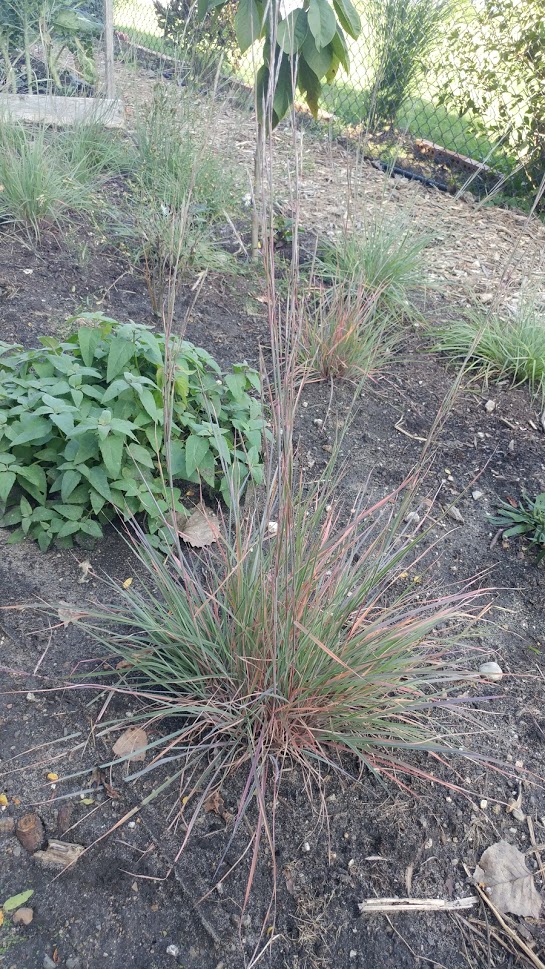
We will plant this only in the long term Full sun meadow in large groupings with a density of 2.5 plants per square yard. So we need 60 plants or so. Another strong reason to use a seed grown selection that we can grow ourselves instead of one we need to purchase or propagate clonally.
Magnus Coneflower (Echinacea purpurea ‘Magnus’)
This is yet another Perennial Plant Association’s Perennial Plant of the Year™, this time from 1998.
Magnus is a strain that comes true from seed. So we can grow it ourselves. I almost can’t imagine a meadow planting without a coneflower, but the reason we are adding it here is that it tolerates more shade than the Black Eye Susan we are using in the full sun meadow areas. We will use this instead as a replacement in the area by the Swamp White Oak. The bloom time should be similar, but not as long into the end of the season.
It will also grow a bit taller so we will make larger groups of these as I think it will look better.
We will plant these in groupings of 7 to 15 but we will up the density to 2.5 plants per square yards of planting space. Thus the 20 sq yards of this area will require 50 plants.


White Wood Aster (Eurybia divaricata)
We will also substitute a fall bloomer that tolerates a bit more shade than the Aromatic Aster. For this, we will choose the White Wood Aster. This is a sun and shade tolerant species that can be grown from seed.
It is a lower growing species that stays under 2 feet tall and acts as an effective ground cover until it flowers later in the season. Its white flowers appear between August and October. Like purple coneflower, it will seed about and the two will do a good job filling and gaps in the plantings.

It is a native of the eastern US. A Midwest native that was very similar is the Big Leaf Aster (Eurybia macrophylla). This one, however, does need some shade, so it may not do that well until the Oak tree grows a bit. It also flowers a bit earlier.
We will plant these in groupings from 3 on up. We will up the density to 2 plants per square yards of planting space. Thus the 20 sq yards of this area will require 40 plants.
Heavy Metal Switch Grass (Panicum virgatum ‘Heavy Metal’)
The last plant we will add is a cultivar of a native prairie grass that can tolerate a bit of shade. This bluish foliage colored switchgrass will help to echo the tones of the Prairie Blues Little Bluestem while also adding some variety and structure with its relatively tall height of 4-6′.
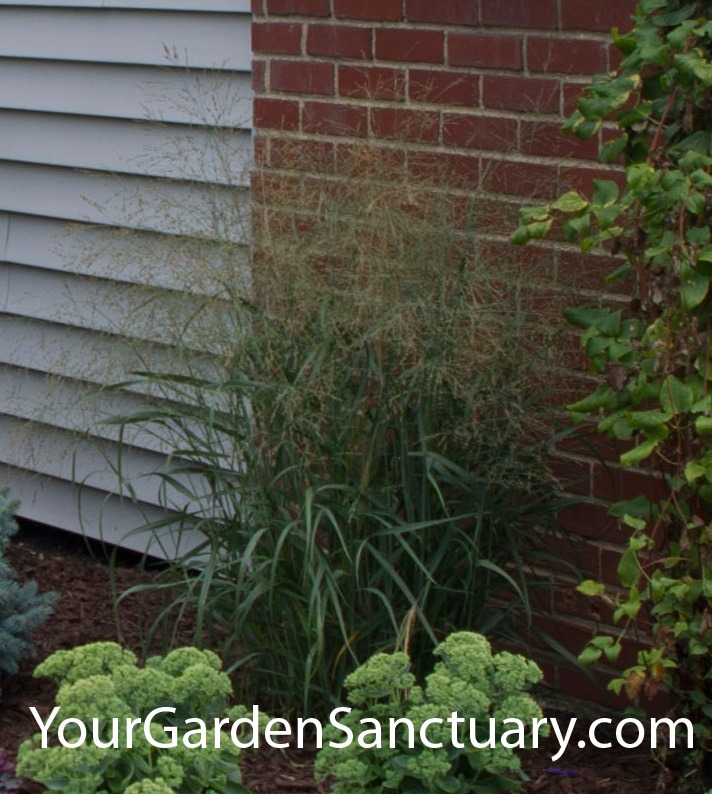
It will also add a different fall and winter color than the Little Bluestem with its eventually straw colored foliage that stands tall in the winter contrasting with the more reddish and lower growth habit of the Little Bluestem.
We will only be planting twelve of these total.
Meadow Plantings Recap
In reality, I would field site these perennials. I would not strictly follow the planting plan I showed. I included it to help give an idea of how I would arrange them.
For instance, I have a Baptisia that is partially blocking the view of the pond from the bench. I would site this plant to help frame the view of the pond from the bench while also giving critters a place to hide from me if they were shy.
To recap our Meadow Mix #1 for our meadow areas that will stay full sun (34 sq yards) includes:
- 5- Blue Sundae False Indigo (Baptisia Decadance ‘Blueberry Sundae’ planted as individuals
- 60 – Huskers Red Beardtongue (Penstemon digitalis ‘ Huskers Red’) planted in groups of 5 to 11
- 45 – Showy Black Eye Susan (Rudbeckia fulgida var. speciosa) planted in groups of 3 to 8
- 45 – Aromatic Aster (Symphyotrichum oblongifolium) planted in groups of 3 to 8
- 60 – Prairie Blues Little Bluestem (Schizachyrium scoparium ‘Prairie Blues’) planted in large groupings
- 5 – Heavy Metal Switch Grass (Panicum virgatum ‘Heavy Metal’) planted individually in the sunny meadow
While our Meadow Mix #2 for the Full Sun area that will gradually become part shade (20 sq yards) includes:
- 40 – Huskers Red Beardtongue (Penstemon digitalis ‘ Huskers Red’)
- 50 – Magnus Coneflower (Echinacea purpurea ‘Magnus’) planted in groups of 7 to 15
- 40 – White Wood Aster (Eurybia divaricata) planted in groups of 3 on up
- 7 – Heavy Metal Switch Grass (Panicum virgatum ‘Heavy Metal’) planted in groups of 1 to 3
A Rendered View if all the perennials would bloom at once (thankfully they don’t)
Yes I would add even MORE plants
All of the perennial plants are late spring to autumn blooming, so we will add a mix of Spring bulbs to spice up the plantings early in the year. This will also add benefits for early spring pollinators. Shooting star (Dodecatheon meadia) is also a nice native Spring ephemeral that would also work in both meadow areas.
There are too many choices here, that will have to be another post. Although a long time ago, I did write a basic post about bulbs.
I would also switch out some of the perennials in this plan with other plants that add a bit of variety. For instance, I would replace one or two groupings of the Asters with Goldenrod as well as some Black-eyed Susan with Monarda to add some accent plants to the planting.
Hopefully, you found this post as well as the first two describing this ecological landscape design, Trees for Carbon Sequestration and Wildlife Support and Wildlife Friendly Garden Design interesting and informative. If you would like, you can click here to subscribe to my email list to receive new posts as they are published.

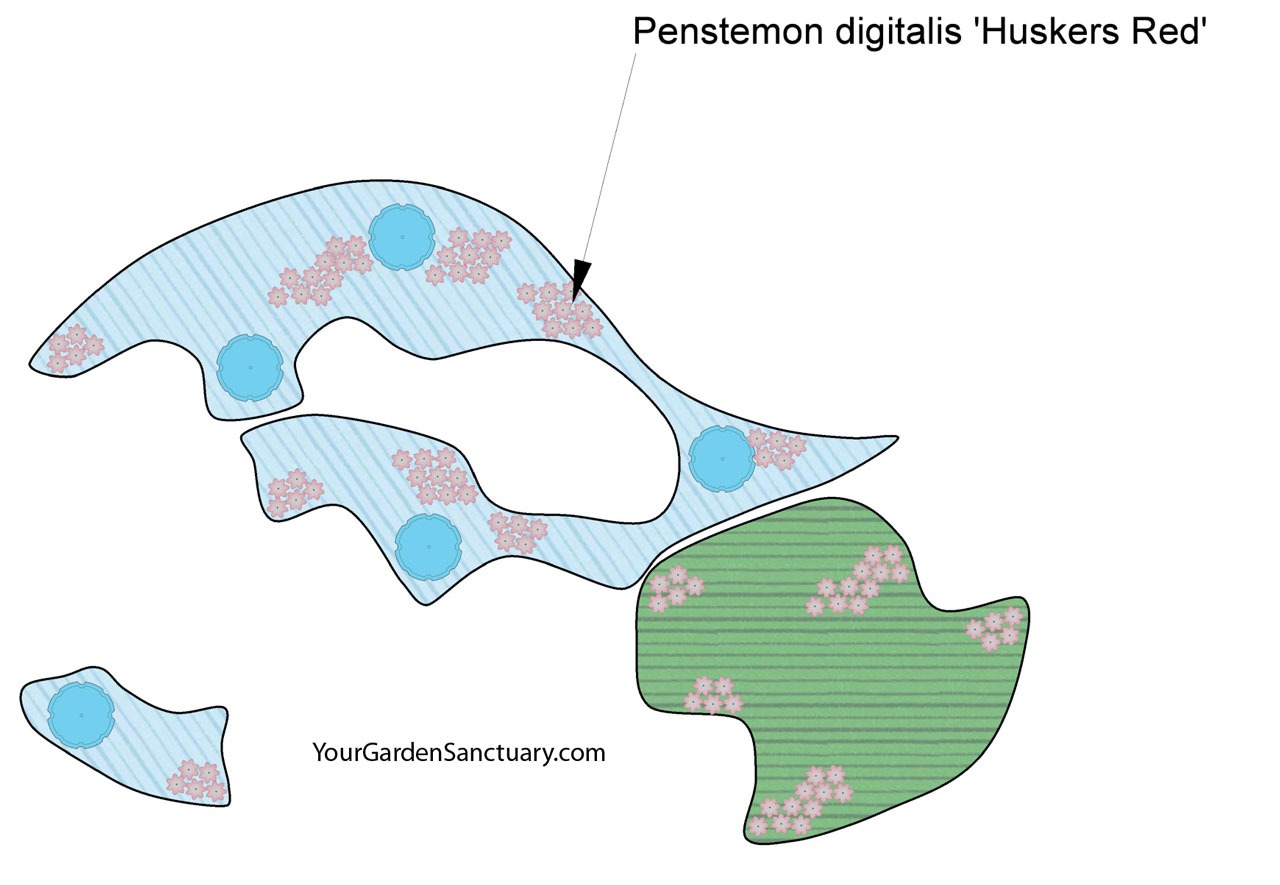
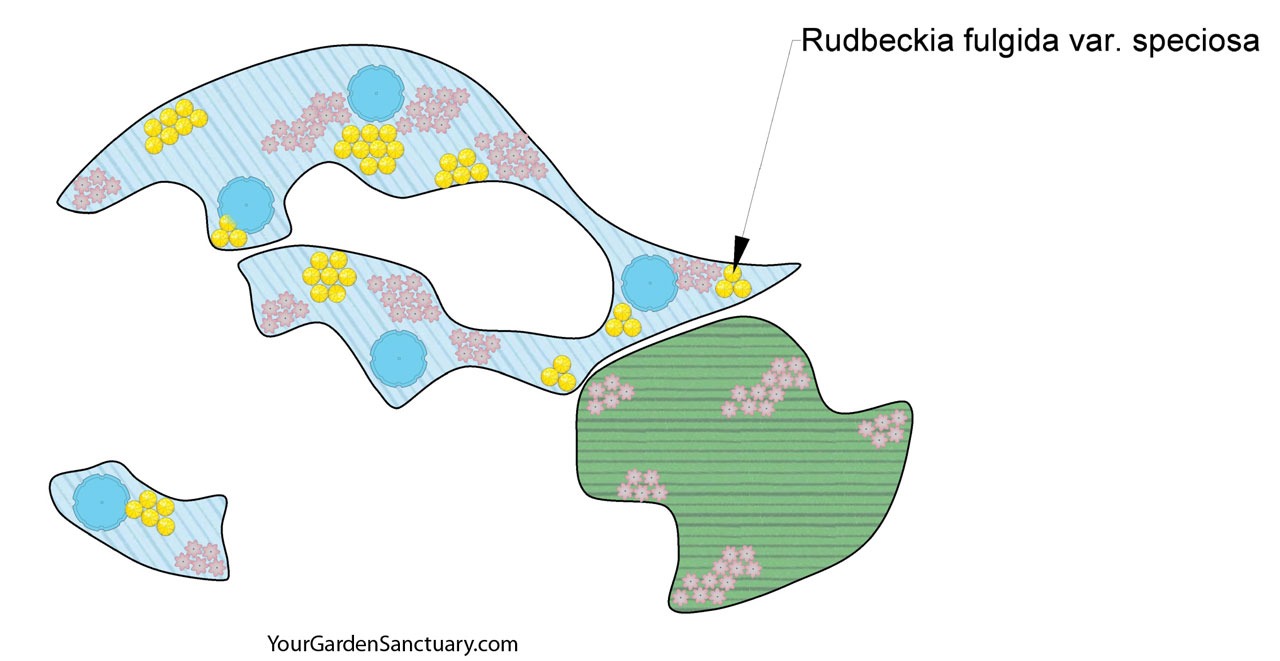

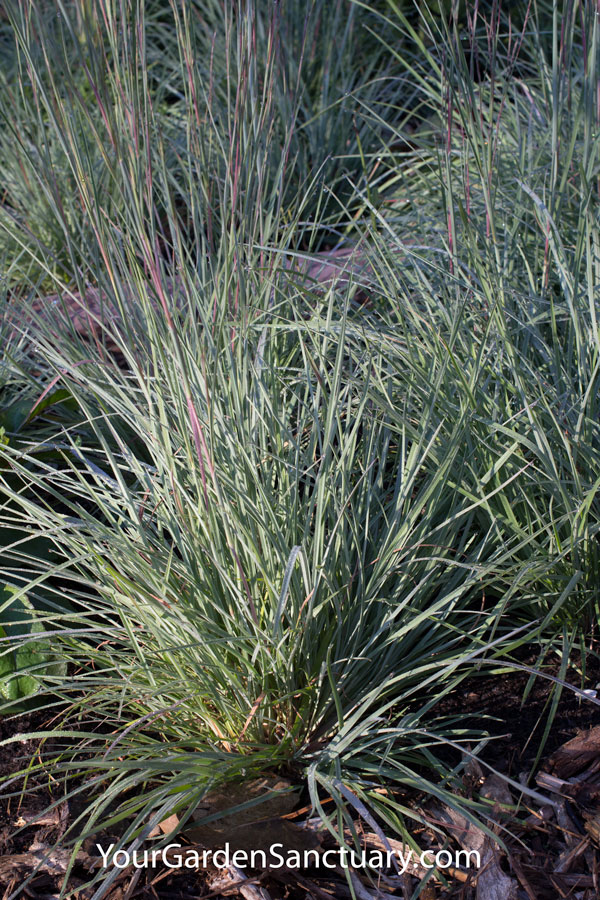
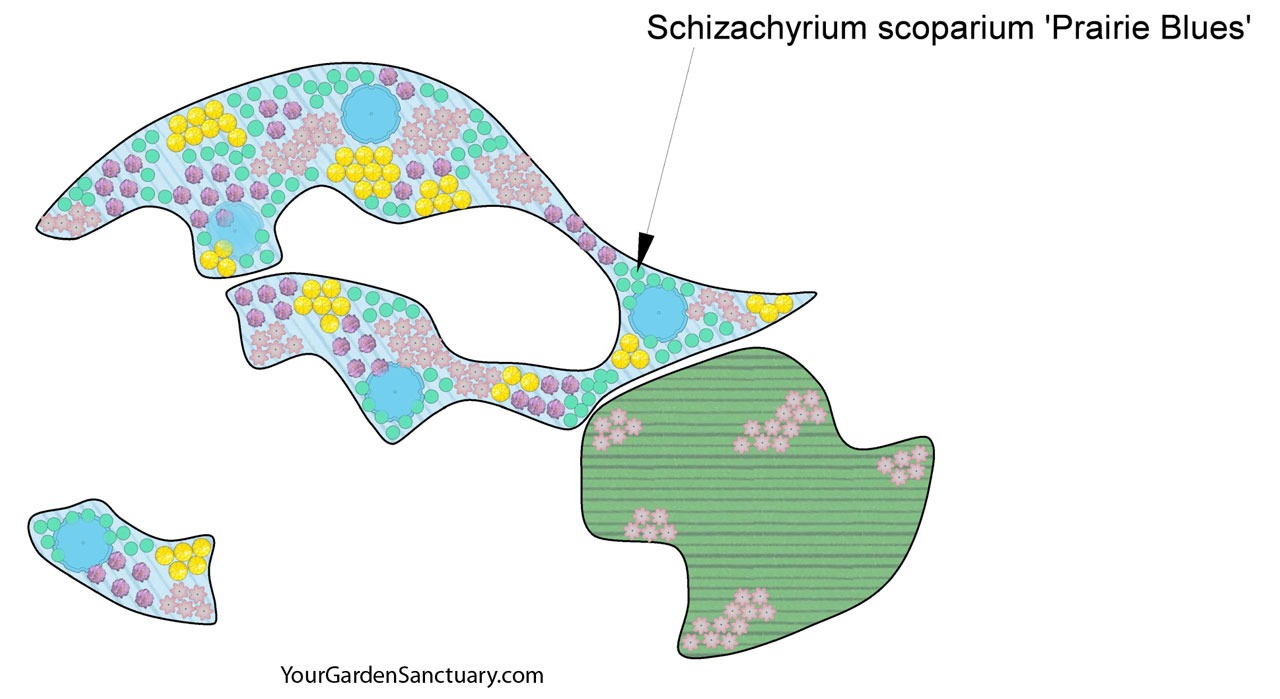
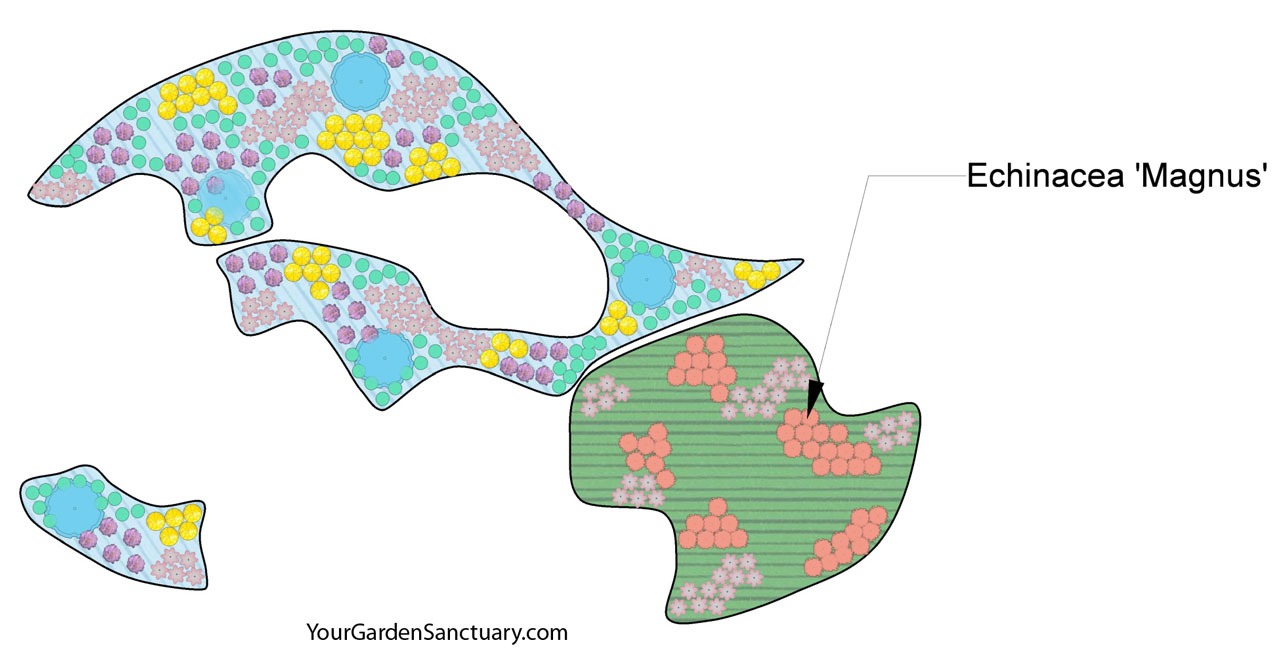
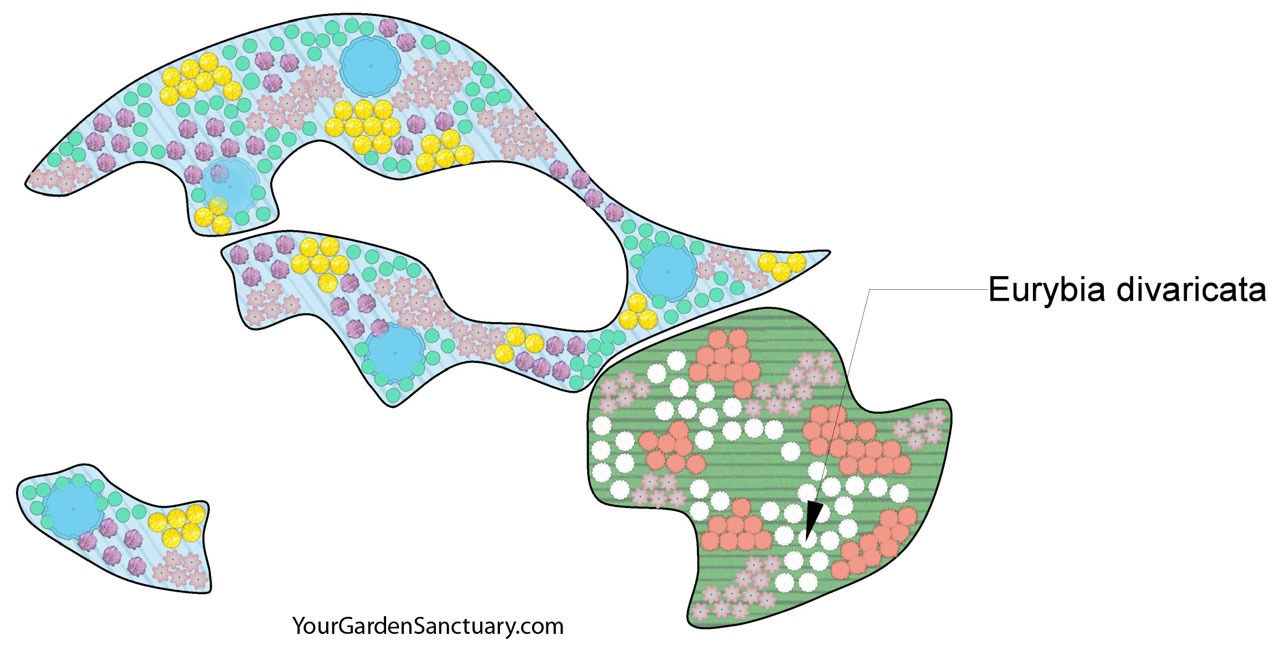



Lauren says
Thanks for the info! I live in Greenville, SC and just bought a White Wood Aster and Purple Coneflower from our local native plant sale. I have a large oak tree in our backyard (we believe it was planted when our house was built, in the 60s) and was wondering if I could plant these around its trunk, or if that would be too much shade for the flowers or if the oak would compete for nutrients. I’d like to plant something around the oak tree trunk that is native and good for local wildlife. Thanks!
Carol Swenson says
I’m so excited. I just discovered your site. I’ve been visualizing transforming my backyard into a beautiful, native abode for birds and insects to enjoy along with me. I really needed this help. Everything you offer here is totally useful. Thank you. Thank you.
Jennifer says
Thank you for sharing your knowledge! I have a question about best trees to plant (maybe 4-5) along a road in the blaring sun in piedmont/upstate area of South Carolina (Anderson). The reason for planting is mainly for carbon sequestration as my almost 13 year old daughter is highly concerned for our environment. This will be a birthday present for her. We would prefer something around 30-50 feet if possible. I have been looking at Dura Heat River Birch, Chinese evergreen oak to name a couple but when I feel like I find a good one for heat, sun, area etc then I can’t find the carbon info on them. Thank you!
Jim says
Dura heat River birch would be a good choice.
Beth Bechand says
Just found this website…was researching how to prune my “Little King” birch. Your article and pictures were VERY HELPFUL! I have been creating my own garden sanctuary for many years. Looking forward to reading both past and future articles. Thanks!
Merula says
Thanks for sharing your knowledge! As usual, great suggestions and I appreciate that you share your reasoning with us. Helps me make my garden better. 🙂
Marianne Lazarus says
Jim, I enjoy reading about your garden jealously, with not enough oomph to copy your ideas to my back yard in eastern Massachusetts.
It would help in understanding shade if you could indicate North on your plans.
Thanks for sharing.
Rebekah says
Fascinating! I really enjoy all of your posts – thank you!